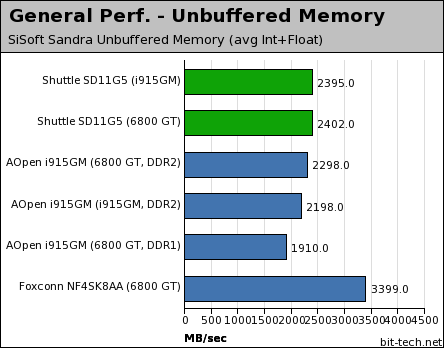
Changes to the way we're doing things...
After a recent editorial, we have decided to change the way we review motherboards here at bit-tech. We've moved our focus away from synthetic benchmarks that provide meaningless numbers from scenarios the consumer rarely finds themselves in.With the exception of SiSoft Sandra's Unbuffered Memory bandwidth benchmark - which, incidentally, measures real memory bandwidth when you need it most - all of our benchmarks have been engineered to give you numbers that you are likely to find useful when actually using the products we have evaluated in the real world. There are plans to increase the number of benchmarks over time and we're running additional tests that will not be published until we have enough products to make a reasonable comparison.
We are also focusing a lot more of our time on evaluating the stability of the motherboards (and platforms) using a stress test designed to highlight any of the potential weaknesses that the product may have. That involves a gradually increasing amount of stress starting with Prime95 and expanding to IOMeter and 3DMark03 if all is well. This is to ensure that all parts of the system are stressed simultaneously over a period of time.
We believe that the consumer is never likely to subject their platform to this level of stress and we are not expecting every product to complete an entire extended stress test. However, most poorly engineered products fail within the first couple of hours, or even minutes, allowing us to make a conscious decision on whether a motherboard (or platform) is worth your money, regardless of how well it performs in our benchmarks.
Test Setup
Intel Pentium M 2.13GHz (133x16, 2MB L2); Shuttle SD11G5; 2 x 512MB Corsair PC5400UL DDR2 (operating at 533MHz in dual channel with 3-2-2-8 timings); NVIDIA GeForce 6800 GT (operating at 350/1000MHz); Western Digital Raptor 74GB; Windows XP Professional Service Pack 2; DirectX 9.0c; NVIDIA ForceWare 71.89 WHQL, Intel Inf 7.00.1.Intel Pentium M 2.13GHz (133x16, 2MB L2); AOpen i915GMm-HFS; 2 x 512MB Corsair PC5400UL DDR2 (operating at 533MHz in dual channel with 3-2-2-8 timings); NVIDIA GeForce 6800 GT (operating at 350/1000MHz); Western Digital Raptor 74GB; Windows XP Professional Service Pack 2; DirectX 9.0c; NVIDIA ForceWare 71.89 WHQL, Intel Inf 7.00.1.
Intel Pentium M 2.13GHz (133x16, 2MB L2); AOpen i915GMm-HFS; 2 x 512MB Corsair PC3200XL DDR1 (operating at 400MHz in dual channel with 2.0-2-2-5 timings); NVIDIA GeForce 6800 GT (operating at 350/1000MHz); Western Digital Raptor 74GB; Windows XP Professional Service Pack 2; DirectX 9.0c; NVIDIA ForceWare 71.89 WHQL, Intel Inf 7.00.1.
AMD Athlon 64 4000+ (Clawhammer, 1MB L2); Foxconn WinFast NF4SK8AA-8EKRS (NVIDIA NForce 4 SLI); 2 x 512MB Corsair 3200XL Pro (operating at 400MHz with 2.0-2-2-5 timings); NVIDIA GeForce 6800 GT (operating at 350/1000MHz); Western Digital Raptor 74GB; Windows XP Professional Service Pack 2; DirectX 9.0c; NVIDIA ForceWare 71.89 WHQL.
Memory Performance

Stability
Whilst smaller motherboards cause greater EMF between the more closely packed components that can cause instability, we suffered no ills with the Shuttle SD11G5. It stood up to our torture testing and was 100% stable through 24 hours of Prime95, 3DMark03 and IOMeter. All the tests we performed were completed without an issue - the system was a pleasure to use and is a credit to Shuttle.
MSI MPG Velox 100R Chassis Review
October 14 2021 | 15:04






Want to comment? Please log in.